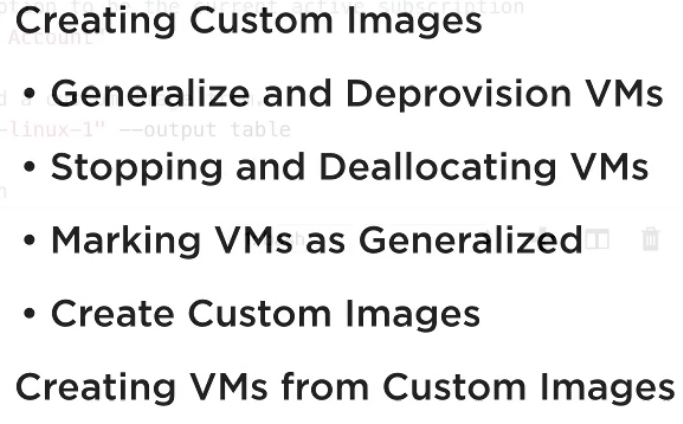Microsoft tutorial Capture linux image
#Deprovisioning and creating a Linux custom image using Azure CLI
#Ensure we're using bash for this demo
bash
#login interactively and set a subscription to be the current active subscription
az login --subscription "Demonstration Account"
#Find the IP of the VM we want to build a custom image from.
az vm list-ip-addresses --name "psdemo-linux-1" --output table
#Connect to the virtual machine via ssh
ssh demoadmin@168.61.212.180
#Deprovision the virtual machine
sudo waagent -deprovision+user -force
#log out of the VM
exit
#In Azure CLI, deallocate the virtual machine
az vm deallocate \
--resource-group "psdemo-rg" \
--name "psdemo-linux-1"
#Check out the status of our virtual machine
az vm list \
--show-details \
--output table
#Mark the virtual machine as "generalized"
az vm generalize \
--resource-group "psdemo-rg" \
--name "psdemo-linux-1"
#Create a VM from the custom image we just created, simply specify the image as a source.
#Defaults to LRS, add the --zone-resilient option for ZRS if supported in your Region.
az image create \
--resource-group "psdemo-rg" \
--name "psdemo-linux-ci-1" \
--source "psdemo-linux-1"
#Summary image information
az image list \
--output table
#More detailed image information, specifically this is a managed disk.
az image list
#Create a VM specifying the image we want to use
az vm create \
--resource-group "psdemo-rg" \
--location "centralus" \
--name "psdemo-linux-1c" \
--image "psdemo-linux-ci-1" \
--admin-username "demoadmin" \
--authentication-type "ssh" \
--ssh-key-value ~/.ssh/id_rsa.pub
#Check out the status of our provisioned VM from the Image and also our source VM is still deallocated.
az vm list \
--show-details \
--output table
#Try to start our generalized image, you cannot.
#If you want to keep the source VM around...then copy the VM, generalize the copy and continue to use the source VM.
az vm start \
--name "psdemo-linux-1" \
--resource-group "psdemo-rg"
#You can delete the deallocated source VM
az vm delete \
--name "psdemo-linux-1" \
--resource-group "psdemo-rg"
#Which will leave just the Image in our Resource Group as a managed resource.
az resource list \
--resource-type=Microsoft.Compute/images \
--output table
Custom virtual machine

#Demo Setup
az extension remove --name image-copy-extension
#login interactively and set a subscription to be the current active subscription
az login --subscription "Demonstration Account"
#0 - List the images in our Subscription
az image list --output table
#1 - Let's say we started a new Resoruce Group in the East US Region.
az group create \
--name "psdemo-rg-1" \
--location "eastus"
#2 - Let's try to create a VM from a custom image that's in another Azure Region, which will error out...
az vm create \
--location "eastus" \
--resource-group "psdemo-rg-1" \
--name "psdemo-linux-1e" \
--image "psdemo-linux-ci-1" \
--admin-username demouser \
--ssh-key-value ~/.ssh/id_rsa.pub
#3 - We need to get a copy of our image into that Azure Region, we'll need the image copy extension for that.
#For more info on this extension and the copy process see:
# https://www.microsoft.com/developerblog/2018/02/15/copy-custom-vm-images-on-azure/
#For more info on how to do this in PowerShell:
# https://michaelcollier.wordpress.com/2017/05/03/copy-managed-images/
az extension add \
--name image-copy-extension
#4 - Then we can copy our image between our Resource Groups and Regions. Creates a Temp Storage Account, then cleans it up.
#May take 5-10 minutes
az image copy \
--source-object-name "psdemo-linux-ci-1" \
--source-resource-group "psdemo-rg" \
--target-location "eastus" \
--target-resource-group "psdemo-rg-1" \
--target-name "psdemo-linux-ci-1-east" \
--cleanup
#List all images in our Subscription
az image list \
--output table
#5 - Retry, creating a VM in the new RG, in the East US Region where our image has been copied.
az vm create \
--location "eastus" \
--resource-group "psdemo-rg-1" \
--name "psdemo-linux-1e" \
--image "psdemo-linux-ci-1-east" \
--admin-username demouser \
--ssh-key-value ~/.ssh/id_rsa.pub
#6 - Look at our currently provisioned VMs
az vm list \
--output table
#7 - Delete an specific image
az image delete \
--resource-group "psdemo-rg-1" \
--name "psdemo-linux-ci-1-east"
#7 - Custom Images in the Azure Portal
#Sort by type, click on one of our images.
open 'https://portal.azure.com/#@nocentinohotmail.onmicrosoft.com/resource/subscriptions/fd0c5e48-eea6-4b37-a076-0e23e0df74cb/resourceGroups/psdemo-rg/overview'